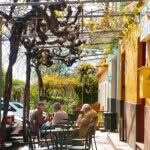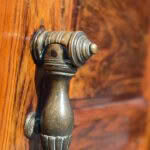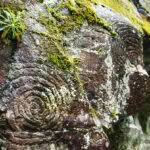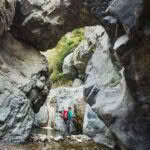The healing powers of a hiking holiday in the Canary Islands

The church of San Miguel, built in 1513, towers over the old town of Tazacorte.
A walking holiday on the island of La Palma reconnects two couples separated not by distance but by mental illness.
Words and photos: Don Fuchs
This article was first published in March/April 2020.
It all started with the receipt in Sydney of an old-fashioned postcard to mark my birthday. It came from Munich, from friends of three decades who had suddenly thought of me while sitting in one of their favourite restaurants in Puerto Tazacorte on the island of La Palma.
Watching the late sun drench the palm-lined esplanade in warm orange hues inspired them to add to their birthday wishes: “Maybe one day we can holiday on La Palma together.” That was in April, and it was the first contact after a long gap of eight years. By early November, we two couples were in Munich boarding an aircraft headed for Santa Cruz de la Palma. We were escaping the cold, murky drizzle of Bavaria’s capital and entering the foggy realms of rekindling our relationship.

Pushed by trade winds, clouds cover the lower parts of La Palma. Only the highest peaks, such as Pico de las Nieves and Pico de Teide on neighbouring Tenerife, stay above this ocean of clouds.
La Palma is one of the Canary Islands, a remote archipelago of eight islands off the coast of West Africa. It is a popular walking destination for sun-hungry Europeans as the Spanish island seems to linger in eternal spring. Also known as “the beautiful island”, La Palma is the favourite holiday destination of our friends. They are keen walkers. They adore the island’s people and the island for its stunning beauty, its food and, best of all, its climate. La Palma also holds happy memories for them, memories of better times and, recently, memories of the end of challenging times.
It’s the first time we’ve traveled together for many years. We rent a villa near Todoque on the dry western slopes of the island. From the terrace, we see banana plantations spill down to the Atlantic Ocean. Sunrise is glorious from this vantage point. We cook together. We walk. Our friendship is just like before when everything was good. But there is an elephant in the room that walks everywhere with us: guilt. For losing contact. For our lack of understanding. For not coping.

The picturesque village is sheltered by the sheer walls of the Barranco de las Angustias.
It reveals itself while we’re climbing out of the deep ravine of the Barranco de Cueva Grande along the Camino Real de la Costa on La Palma’s rugged west coast. It is a long-distance walk on the old footpath that once connected towns and villages encircling the island. Strange-looking dragon trees frame the track. Deep below us, the ocean is iridescent blue.
I walk with him; the women are a few metres back. His wife has been very chatty all morning, almost manic. So much so that my internal warning lights go on. “Is she all right?” I ask him. He smiles and says simply, “Everything’s good. She’s happy.”

The black sand beach of Puerto Tazacorte attracts sun-worshiping Europeans.
Happiness, however, was in short supply in the years between 2008 and 2016. After a long period of declining health and confusing behaviour, the crisis occurred when my friend’s wife had a severe breakdown and ended up in emergency care after a suicide attempt. What followed were many months of ups and downs until she was finally diagnosed with paranoid psychosis. With that diagnosis, an incredibly trying period in their lives was only just beginning.
We plan to walk every day, explore the vastly different faces of the island, enjoy the villa and sample local food. More importantly, however, we want to make sense of the past years. To explain, to understand, to reconnect. We remember Munich 2008, the last time we holidayed and spent time together. We sensed a certain vagueness in her. Getting a cup of coffee took more than an hour. There was no focus, only disconnection and disjointed conversations. A week later, we were back in our home of Sydney when we received a strange phone call in the middle of the night. “Are you all right?” she asked before adding incomprehensibly: “We’re here for you.” We knew something was wrong. And it was. A week later: the breakdown.
- The village of Tijarafe along the Camino Real de la Costa is known for its colourful buildings.
- Grilled squid, served with a mild aioli, is one of the specialities on La Palma.
- A fountain in the centre of Tazacorte.
- Bougainvillea shades benches next to the church of San Miguel in Tazacorte.
- The people of Tijarafe are proud of their architectural heritage.
- A small street café in Tijarafe invites walkers and locals alike.
Watching from a distance, we were silenced by our great sense of helplessness and her attempts to push us away. We used the geographical distance as an excuse. Now we feel guilty. During a stroll through Los Llanos de Aridane, a picturesque town with colourful houses and an astonishing array of artful brass door knockers, she gives us absolution. “I felt the need,” she says, “to deal with it alone.”
On the wet and remote northern side of La Palma, moist trade winds push clouds against the steep mountains, and lush laurel forest covers the ravines and steep slopes. It is a lost world, rugged, seemingly inaccessible. We drive to the Parque Cultural La Zarza, famous for its ancient petroglyphs hidden on volcanic rocks in the twilight of dense, forever-damp forest. These mysterious rock carvings were left there by the Benahoritas, a mystical people who first colonized the remote island. The park is also the starting point of an exciting walk. A steep track descends into a dark, damp ravine. Ferns and moss cover the rock under the dense canopy and a thick layer of cloud shields the sun. It rarely rains on La Palma, but water is abundant: the trees “milk” the clouds, creating a constant drizzle.

Walkers negotiate one of the premier walks on the island, the dramatic ravine of the Barranco de las Angustias in the Caldera de Taburiente National Park.
Walking is excellent for many things; conversation is one of them. I ask my friend how friends and families dealt with her illness, knowing that we had our own difficulties in understanding what was going on. His answer is shocking. “Divorce her and put her in an institution because she’s a liability,” had been the advice of his two brothers. Many friendships petered out during this period.
“And you,” I ask, “how did you deal with it?”
“I studied the illness,” he replies. With his scientific background, his approach was pragmatic. He went online, questioned doctors, analyzed papers in medical journals and became something of an expert. Learning and studying helped him to understand and cope. However, keeping his emotions in check came at a price. “There were days when I thought I couldn’t go on any longer,” he admits.
- In the old quarters of Los Llanos de Aridane, one of the larger towns on the island, entrance doors are fitted with brass door knockers of all shapes and forms.
Some evenings, we don’t cook, and instead, we visit the alfresco restaurants in Puerto de Tazacorte. The little village, built under towering cliffs at the mouth of a vast barranco, or ravine, is protected from the ocean swell by a massive breakwater. The coarse black sand beach attracts swimmers on calm days.
There we plan our next walks. One of their favourite places is the Caldera de Taburiente, a gargantuan natural amphitheatre in the centre of the island, surrounded by towering mountains reaching heights of over 2000 metres. This astonishing landscape is protected within the Caldera de Taburiente National Park. A dramatic walk through the gorge of the Barranco de las Angustias, the Gorge of Anguish, leads into the core of the island. This is the walk they’re especially keen to show us. The vegetation is first dominated by succulents and spurges, plants that require little moisture to survive. Higher up, fragrant pine forests create a different atmosphere. Deep in the barranco, a creek is running, and its gurgling sound is a steady companion into the caldera.

Puerto Tazacorte on the west coast of La Palma is famous for its alfresco restaurants, sunny climate and black sand beach. It hardly ever rains here.
Our friend’s illness is not always the topic of conversation, but it’s unavoidable. We feel the need to understand. On that day in the Barranco de Angustias, I learn that the search for the right medicine and then the right doses lasted more than three years. It was trial by error, and the doctors got it wrong several times. The effects were often devastating, and terrible side effects plagued her.
“I had weeks where I couldn’t sleep properly,” she remembers. “My brain was on fire. I couldn’t relax for weeks on end.”

A dragon tree dwarfs hikers along the Camino Real De La Costa. The tree has become a symbol of the Canary Islands.
Now, her joy in life is back. She’s as she was before: funny in a quirky way, motivated, adventurous, caring, open to everything. We walk past huge boulders of pillow lava, formed when La Palma was still an underwater volcano. An ancient, twisted pine tree with bark like the skin of a reptile becomes the object of our admiration.
At Dos Aquas, where two creeks merge, we decide to turn around. High above looms the rock spire of the Roque Idafe. Can the illness come back? I want to know. “Yes,” he says, “but now I can tell by the way she walks when it’s coming and that we need to adjust her medication.”
- Laurel forests cover the ravines near the Zarza Cultural Park in the remote north of La Palma.
- Moist clouds shroud the plains of the Parque Natural de Cumbre Vieja.
- A boulder of pillow lava in the Barranco de las Angustias reveals the geological history of La Palma.
- The rock spire of the Roque Idafe looms high over Dos Aguas in the Caldera de Taburiente.
- Pine trees and lichen colonize the ash slopes of the Cumbre Vieja.
- Mysterious petroglyphs are the main attraction in the remote Zarza Parque Cultural.
- A natural arch in the Barranco de las Angustias.
A few days later, we are back in the national park. This time it is the rim of the Caldera de Taburiente, accessible by a twisted and spectacular road. From a car park, our friends guide us along a rough walking track to the 2239-metre-high Pico de las Nieves. The pine forest is below us, and the views take our breath away. To the southwest, the symmetrical summit cone of Pico del Teide, neighbouring Tenerife’s highest mountain, looms over the blanket of white clouds.
The vista into the caldera is spectacular – vivid colours, strange rock formations, a lunar landscape of epic proportions. We watch the clouds flow into the huge valley, filling it slowly. From up here, at least, we feel that the problems of the past have stayed under the clouds.
That night, while sipping local wine at the pool, we start planning future trips. Our friends voice the desire to visit us in Australia and explore Tasmania. The elephant has left the room.
NOTEBOOK

Buskers entertain diners at the popular Taberna Del Puerto in Puerto Tazacorte.
Getting there: There are no direct flights from New Zealand to La Palma. Regular flights to the island leave from Madrid or most major European airports.
Best time to visit: La Palma is an all-year destination thanks to its temperate, spring-like climate. Avoid the major European holiday periods in July/August and around Easter.
Accommodation: There is no lack of hotels and apartments. Renting a villa is popular.
How to get around: A car is convenient. Several car rental companies have counters at La Palma Airport. Try to make do with a small car as La Palma’s roads are steep, windy and narrow. Allow plenty of travel time because progress on the sometimes-adventurous roads is slow. There is an adequate bus network on the island.

Walking: There are about 1000 kilometres of walking tracks on La Palma, ranging from coastal strolls to alpine undertakings. The walks are well marked for hikers. Walking guide books in English and topographical maps are available.
What to take: Good walking shoes are essential as many of the tracks are rough and rocky. Suitable clothing is required for higher walks in the Caldera de Taburiente National Park. Strong winds and low temperatures can make hiking in the mountains treacherous.




















